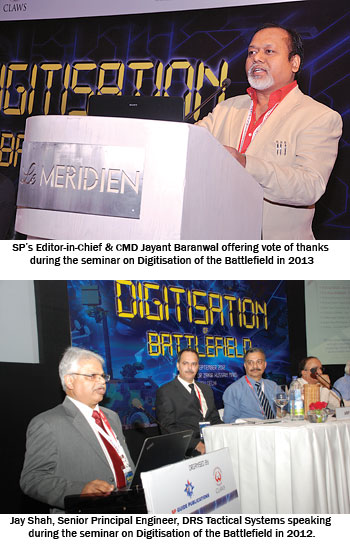INDIAN ARMED FORCES CHIEFS ON OUR RELENTLESS AND FOCUSED PUBLISHING EFFORTS

The insightful articles, inspiring narrations and analytical perspectives presented by the Editorial Team, establish an alluring connect with the reader. My compliments and best wishes to SP Guide Publications.

"Over the past 60 years, the growth of SP Guide Publications has mirrored the rising stature of Indian Navy. Its well-researched and informative magazines on Defence and Aerospace sector have served to shape an educated opinion of our military personnel, policy makers and the public alike. I wish SP's Publication team continued success, fair winds and following seas in all future endeavour!"

Since, its inception in 1964, SP Guide Publications has consistently demonstrated commitment to high-quality journalism in the aerospace and defence sectors, earning a well-deserved reputation as Asia's largest media house in this domain. I wish SP Guide Publications continued success in its pursuit of excellence.
- Appointments Committee of Cabinet approves one-month extension in service of Chief of the Army Staff
- Admiral Dinesh K. Tripathi assumes Command of the Indian Navy as 26th Chief of the Naval Staff
- Prime Minister witnesses 'Bharat Shakti' – a Tri-Services Firing and Manoeuvre Exercise in Pokhran, Rajasthan
- Interim Defence Budget 2024-25 — An Analysis
- Union Defence budget 2024
- Prime Minister Modi Commemorates Indian Navy Day in a Grand Ceremony
Last mile connectivity, key in a tactical battle area

For the third consecutive year, SP Guide Publications is organising the international seminar on ‘Digitisation of Battlefield’, this time in association with the Federation of Indian Chambers of Commerce and Industry (FICCI) on October 27 at the FICCI Auditorium in New Delhi.
In the earlier two editions, SP Guide Publications had associated with the Centre for Land Warfare Studies (CLAWS) which had evinced substantial interest from serving officers, defence industry and private multinational companies. This year the interest generated for the upcoming event is very encouraging. The seminar will be inaugurated by the Minister of State for Defence, Rao Inderjit Singh, and the keynote address will be delivered by Lt. General Philip Campose, Vice Chief of Army Staff, Integrated HQ of the Ministry of Defence.
The theme of this year’s seminar is ‘Extending Network Centricity to the Last Mile in the Tactical Battle Area’. The seminar aims to analyse the requirement of net-centric capability at the national level; examine Indian military’s net-centric warfare (NCW) capacity building; overview of the Army’s Tactical Command, Control, Communications and Information (TacC3I) system; examine the concept and road map of the Battlefield Management System (BMS); examine space as a force multiplier in the digitised battlefield, etc.
Indigenisation is still a far cry and India has a long way to go in developing core battlefield technologies. With the new government led by the Prime Minister Narendra Modi giving a fresh fillip to the indigenisation process through the launch of the ‘Make in India’ campaign, it is expected that the defence industry will shift gears soon.
The aim of the seminar is to highlight and review the magnitude and complexity of the programme and to outline the role the industry could play in assisting the Indian Army, given the new energised economic reforms scenario in India.
What is digitisation all about? According to Cisco, IP-based networks provide a platform to connect everything that flies, drives, walks or sails. Every military unit is a node on the network. A common standards-based infrastructure enables voice, video, data and mobility on one network and provides unique global accessibility with the potential to reach anyone, anywhere, using any communications device.
A network-centric approach to homeland security and public safety communications enables government agencies and disaster response organisations to respond more effectively and efficiently to unpredictable challenges. First responders and homeland security agencies can now perform secure, real-time collaboration and surveillance while sharing information across the local, regional and national agencies. An intelligent network enables the rapid collection, analysis and distribution of voice, video and data traffic. These network-centric communications and technology solutions support established homeland security priorities in their jurisdictions, addressing issues in the areas of public safety and first response, public health, transportation and critical infrastructure protection.
As new challenges and threats confront the global defence, space, homeland security and public safety sectors, more intelligent networks are needed to achieve operational effectiveness and to efficiently cope with reduced budgets, staffing and time.
Many government entities have begun to deploy more mobile and ubiquitous IP-based solutions that bring the power of the network to their respective missions, at home or abroad. Defence, commercial and civil space organisations are looking to commercial off the shelf (COTS) technologies to reduce deployment time lines and provide next-generation global services at reduced costs. At the local, regional and national levels, public safety agencies are focusing on overcoming the challenges of radio interoperability and information sharing across agencies with incompatible systems. They are all also looking to implement advanced technologies such as sensor-based video surveillance and seamless wireless networks to accommodate rapid information sharing and real-time collaboration.
The network enables the deployment of converged technologies that deliver critical information to those who need it, when they need it, and how they need it. Standards-based IP networks can make organisations more responsive and adaptable. Commercial companies have migrated to IP-based networks to respond to global competition and adapt to fast-changing market demands.





